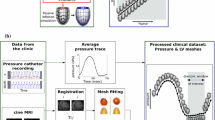Abstract
A simulation study was performed to evaluate different recovery procedures for computing the multipole components of the cardiac electrical activity. A series of dipolar potential distributions was first generated on a realistic numerical model of the human torso. Then, different procedures based on surface integration (SI) and least-squares (LS) minimization were used to compute the multipole components. The parameters of a single moving dipole (SMD) computed from the estimated multipoles were compared with those of the original dipole source. For a finite and homogeneous simulation as well as recovery medium, the results showed that SI employing the potentials over all 1216 surface elements of the torso model was not affected by the various numerical approximations used to perform the integration (e.g., rms error for the SMD position, p=0.7 mm). By integrating the potentials with truncated capping surfaces at the neck and the waist, the recovery errors increased (p=2.1 mm). Sampling the potentials at 63 sites, followed by interpolation over the rest of the torso surface, severely affected the SI results for the SMD (p=6.4 mm), as compared with LS minimization using also 63 values (p=0.9 mm). With lungs and intraventricular blood masses in the simulation medium but a finite and homogeneous recovery medium, SI was less effective (p=10.8 mm) than LS (p=8.6 mm). Adequate compensation for the effects of lungs was obtained by including regions of lower electrical conductivity in the recovery medium for LS, and by a correction matrix for SI. In general, LS gave better results than SI, but with a higher initial computation time.
Similar content being viewed by others
References
Arthur, R.M., D.B. Geselowitz, S.A. Briller, and R.F. Trost. Quadrupole components of the human surface electrocardiogram.Am. Heart J. 83:663–677, 1972.
Arthur, R. M., D.B. Geselowitz, S.A. Briller, and R.F. Trost. The path of the electrical center of the human heart determined from surface electrocardiograms.J. Electrocardiology 4:29–33, 1971.
Barnard, A.C.L., I.M. Duck, M.S. Lynn, and W.P. Timlake. The application of electromagnetic theory to electrocardiology. II. Numerical solution of the integral equations.Biophys. J. 7:463–491, 1967.
Brody, D.A. The inverse determination of simple generator configurations from equivalent dipole and multipole information.IEEE Trans. Biomed. Eng. 15:106–110, 1968.
Cuffin, B.N. Effects of modeling errors on least-squares error solutions to the inverse problem of electrocardiography.Ann. of Biomed. Eng. 9:369–382, 1981.
Gabor, D. and C.V. Nelson. Determination of the resultant dipole of the heart from measurements on the body surface.J. Appl. Physics 25:413–416, 1954.
Geselowitz, D.B. Multipole representation for an equivalent cardiac generator.Proc. IRE 48:75–79, 1960.
Geselowitz, D.B. Two theorems concerning the quadrupole applicable to electrocardiography.IEEE Trans. Biomed. Eng. 12:164–168, 1965.
Guardo, R., B.M. Sayers, and D.M. Monro. Evaluation and analysis of the cardiac electrical multipole series based on a two-dimensional Fourier technique. InThe Theoretical Basis of Electrocardiology, edited by C.V. Nelson and D.B. Geselowitz. Oxford: Clarendon, 1976, pp. 213–256.
Gulrajani, R.M. and G.E. Mailloux. A simulation study of the effects of torso inhomogeneities on electrocardiographic potentials, using realistic heart and torso models.Circ. Res. 52:45–56, 1983.
Horacek, B.M. Numerical model of an inhomogeneous human torso.Adv. Cardiol. 10:51–57, 1974.
Kneppo, P. and L.I. Titomir. Integral characteristics of the human cardiac electrical generator from electric field measurements by means of an automatic cylindrical coordinator.IEEE Trans. Biomed. Eng. 26:21–28, 1979.
Miller, W.T. III and D.B. Geselowitz. Simulation studies of the electrocardiogram. I. The normal heart.Circ. Res. 43:301–315, 1978.
Monro, D.M. Interpolation methods for surface mapping.Comp. Prog. Biomed. 12:145–157, 1980.
Pilkington, T.C. and M.N. Morrow. The usefulness of multipoles in electrocardiography.CRC Crit. Reviews in Biomed. Eng. 7:175–192, 1982.
Pilkington, T.C. and R. Plonsey. InEngineering Contributions to Biophysical Electrocardiography. New York: IEEE Press, 1982, pp. 97–98.
Savard, P., G.E. Mailloux, F.A. Roberge, R.M. Gulrajani, and R. Guardo. A simulation study of the single moving dipole representation of cardiac electrical activity.IEEE Trans. Biomed. Eng. 29:700–707, 1982.
Savard, P., F.A. Roberge, J.B. Perry, and R.A. Nadeau. Representation of cardiac electrical activity by a moving dipole for normal and ectopic beats in the intact dogs.Circ. Res. 46:415–425, 1980.
Schubert, R.W. An experimental study of the multipole series that represents the human electrocardiogram.IEEE Trans. Biomed. Eng. 15:303–312, 1968.
Strang, G.Linear Algebra and Its Applications. New York: Academic Press, 1976, pp. xxx.
Author information
Authors and Affiliations
Rights and permissions
About this article
Cite this article
Dubé, B., Savard, P., Guardo, R. et al. Surface integration and least-squares procedures for the inverse recovery of cardiac multipole components. Ann Biomed Eng 13, 43–58 (1985). https://doi.org/10.1007/BF02371249
Issue Date:
DOI: https://doi.org/10.1007/BF02371249




